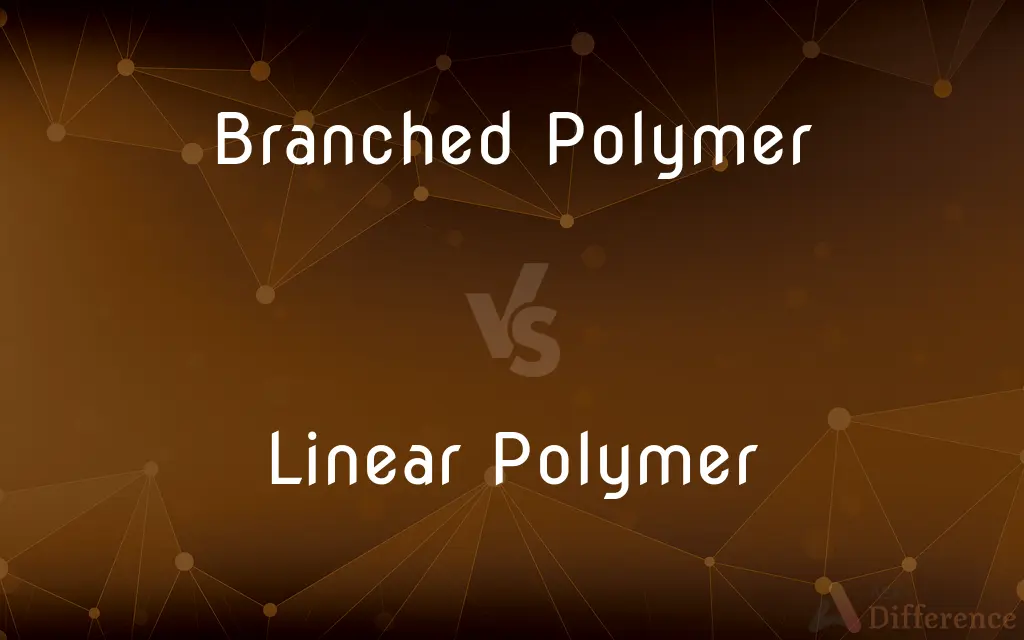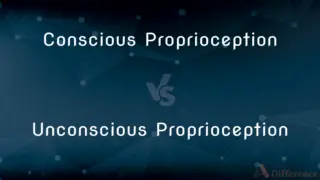Branched Polymer vs. Linear Polymer — What's the Difference?
Edited by Tayyaba Rehman — By Fiza Rafique — Published on December 17, 2023
Branched polymers have side chains off their main chain, while linear polymers have a continuous, straight chain.

Difference Between Branched Polymer and Linear Polymer
Table of Contents
ADVERTISEMENT
Key Differences
Branched polymers are macromolecules that consist of a main backbone with side chains or branches. These branches deviate from the main chain and can greatly affect the polymer's properties. Linear polymers, on the other hand, have a continuous and straight chain without any side branches.
Branched polymers often exhibit unique properties due to their structural complexity. This complexity can lead to entanglements and varying degrees of crystallinity. Linear polymers, in contrast, typically exhibit more predictable behaviors because of their straightforward chain structure.
In processing and applications, the branching in branched polymers can influence their melt viscosity and other characteristics. Linear polymers, because of their uncomplicated chain, might flow more easily under certain conditions than their branched counterparts.
Branched polymers can sometimes pack less efficiently in a solid state due to their branches, leading to lower density. Linear polymers, with their straight chains, can pack closely together, often resulting in higher density materials.
Branched polymers' side chains can lead to a more amorphous structure, impacting its transparency and crystallinity. Linear polymers, with a consistent chain, can result in clearer and more crystalline materials under the right conditions.
ADVERTISEMENT
Comparison Chart
Structure
Contains a main chain with side branches.
Has a continuous, straight chain without branches.
Density
Often lower due to less efficient packing.
Typically higher because of close packing.
Crystallinity
Can be more amorphous because of branches.
Tends to be more crystalline.
Processing Characteristics
Might have varying melt viscosity due to branches.
Usually flows more easily.
Application Potential
Can be tailored for specific uses due to branch diversity.
Predictable properties suitable for many uses.
Compare with Definitions
Branched Polymer
A polymer with a primary chain and secondary side chains.
The branched polymer had numerous side chains that influenced its properties.
Linear Polymer
A polymer with consecutive repeating units without deviations.
Linear polymers often result in materials with higher crystallinity.
Branched Polymer
A macromolecule with offshoots from its main structure.
This material's flexibility is due to its nature as a branched polymer.
Linear Polymer
A singular, unbranched polymer chain.
The simplicity of the linear polymer made it a preferred choice for many applications.
Branched Polymer
A polymeric compound with additional side chains.
Due to its status as a branched polymer, the material had varied characteristics.
Linear Polymer
A polymer having a straight and continuous molecular chain.
The clear plastic sheet was made from a linear polymer.
Branched Polymer
A complex polymer with deviations in its primary chain.
The branched polymer showed unique behaviors during the melt process.
Linear Polymer
An unbranched macromolecular structure.
The straightforward structure of the linear polymer allowed for easy processing.
Branched Polymer
A molecular structure with a main chain and supplementary branches.
The branched polymer's branches led to a more amorphous state.
Linear Polymer
A macromolecule without side branches.
The linear polymer exhibited consistent and predictable properties.
Common Curiosities
What is a branched polymer?
A branched polymer is a type of polymer structure that has a main chain with one or more subsidiary chains branching off from it.
How do branched polymers differ from linear polymers?
While linear polymers have a single, continuous chain, branched polymers have additional chains protruding from the main chain.
Why are branched polymers used in certain applications?
Due to their unique structure, branched polymers often exhibit improved solubility, processability, or specific mechanical properties that are desired in certain applications.
What are some examples of branched polymers?
Low-density polyethylene (LDPE) and amylopectin are examples of branched polymers.
How are linear polymers formed?
Linear polymers are typically formed through addition (chain-growth) polymerization or step-growth (condensation) polymerization without the formation of side chains.
What is the significance of molecular weight in polymers?
Molecular weight determines various polymer properties, including mechanical strength, melt viscosity, and solubility. Both branched and linear polymers can have varying molecular weights.
How does branching affect the properties of a polymer?
Branching can reduce the polymer's crystallinity, leading to increased flexibility and lower melting points compared to linear counterparts.
What are some examples of linear polymers?
Examples include high-density polyethylene (HDPE), polyvinyl chloride (PVC), and polystyrene.
How do polymer chains interact in a material?
Polymer chains can interact through van der Waals forces, hydrogen bonds, or other secondary interactions. These interactions influence the overall properties of the material.
What is a linear polymer?
A linear polymer is a polymer whose molecules form a single, unbranched chain of repeating units.
Can both branched and linear polymers be synthesized from the same monomer?
Yes, the method of polymerization and reaction conditions can lead to the formation of either branched or linear structures from the same monomer.
How do the properties of linear polymers compare to branched polymers?
Linear polymers generally have higher crystallinity, higher tensile strength, and higher melting points than their branched counterparts.
What are the applications of linear polymers?
Due to their strength and stability, linear polymers are used in various applications, from containers and pipes to fibers and films.
How are the physical properties of polymers affected by their structure?
The physical properties of a polymer, such as flexibility, tensile strength, and melting point, are significantly influenced by whether the polymer is linear or branched.
Are all synthetic polymers either linear or branched?
No, besides linear and branched polymers, there are also cross-linked polymers, network polymers, and star polymers, among others. The structure chosen depends on the desired material properties and application.
Share Your Discovery

Previous Comparison
Management Information System vs. Decision Support System
Next Comparison
Conscious Proprioception vs. Unconscious ProprioceptionAuthor Spotlight
Written by
Fiza RafiqueFiza Rafique is a skilled content writer at AskDifference.com, where she meticulously refines and enhances written pieces. Drawing from her vast editorial expertise, Fiza ensures clarity, accuracy, and precision in every article. Passionate about language, she continually seeks to elevate the quality of content for readers worldwide.
Edited by
Tayyaba RehmanTayyaba Rehman is a distinguished writer, currently serving as a primary contributor to askdifference.com. As a researcher in semantics and etymology, Tayyaba's passion for the complexity of languages and their distinctions has found a perfect home on the platform. Tayyaba delves into the intricacies of language, distinguishing between commonly confused words and phrases, thereby providing clarity for readers worldwide.
















































